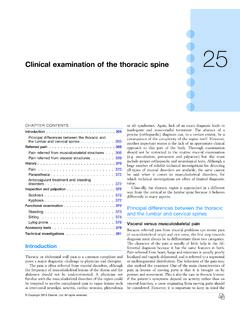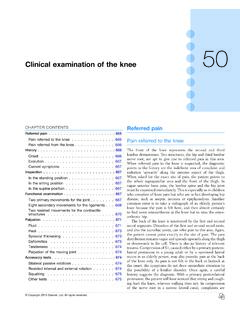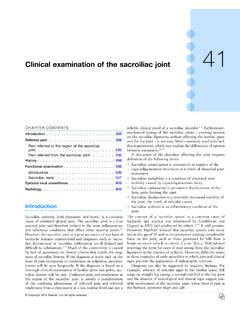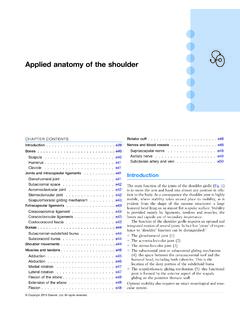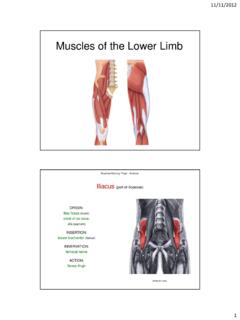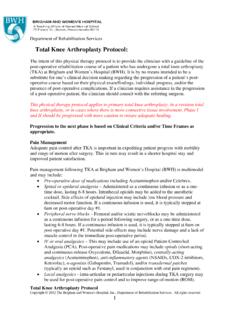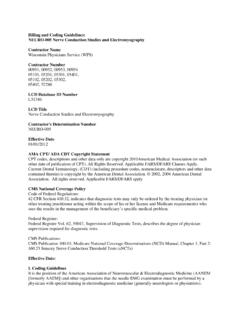Transcription of Nerve lesions and entrapment neuropathies of the lower …
1 Nerve lesions and entrapment neuropathies of the lower limb CHAPTER CONTENTS The effects of pressure on the peripheral nerves of leg and Introduction .. e313 foot are discussed in this chapter. Sciatic Nerve .. e313. Lateral cutaneous Nerve .. e313. Sciatic Nerve femoral Nerve .. e315 Neurocompression syndromes of the sciatic Nerve are not Saphenous Nerve .. e315 common. Some believe that the Nerve can become compressed Common peroneal Nerve .. e315. between the fibres of the piriformis muscle (the piriformis syndrome2). Deep peroneal Nerve .. e316 If the Nerve becomes damaged or is chronically irritated, Superficial peroneal Nerve .. e317 serious deafferentation pain can result and occurs in circum- stances in which the sciatic Nerve is locally bruised or has Tibial Nerve .. e317. undergone damage after local injection of irritating substances. Plantar nerves .. e318 Continuous and burning pain, independent of posture, is then felt in the sensory distribution of the Nerve .
2 Local pressure on the Nerve can increase the pain 4. Introduction Lateral cutaneous Nerve The main symptom of pressure on nerves is paraesthesia. Depending on the level of the compression, paraesthesia is entrapment of the lateral cutaneous femoral Nerve is not accompanied by pain and numbness. The combination of these uncommon and results in meralgia paraesthetica. three symptoms and their interrelation are of importance in The lateral cutaneous Nerve is sensory only. It originates at localizing the site of L2 and runs retroperitoneally to emerge at the outer edge of Pressure on the distal spinal cord induces painless pins and the psoas and then crosses the iliacus muscle at the lateral needles in both feet, soon followed by numbness, incoordina- border of the pelvis, which it follows to the anterior superior tion and abnormal reflexes. This mechanism has been discussed spine of the ilium. It then passes under the lateral aspect of in the chapters on the cervical and thoracic spine.
3 The inguinal ligament to follow the fibres of the sartorius Pressure on a Nerve root causes segmental pain, paraesthesia muscle. Its course and the location as it exits the pelvis are at the distal aspect of the respective dermatome and, if the very variable. Aszmann et al5 investigated its relation to soft- pressure increases, motor and sensory deficit. For detailed tissue and bony landmarks in the inguinal region through dis- descriptions of these pathologies, see the chapters on the section of 52 human anatomic specimens and identified five lumbar spine. different types: type A, posterior to the anterior superior iliac Pressure on the lumbosacral plexus causes little pain but spine, across the iliac crest (4%); type B, anterior to the ante- increasing numbness and weakness. For instance, compression rior superior iliac spine and superficial to the origin of the of the plexus by a neoplasm does not cause pain in the limbs sartorius muscle but within the substance of the inguinal liga- but only sacral or coccygeal pain.
4 However, it does give rise to ment (27%); type C, medial to the anterior superior iliac spine, gross weakness of the muscles of one or both legs and feet. ensheathed in the tendinous origin of the sartorius muscle Copyright 2013 Elsevier, Ltd. All rights reserved. Nerve lesions and entrapment neuropathies of the lower Limb Fig 2 Area innervated by the lateral cutaneous Nerve . Box 1. Fig 1 Course of the lateral cutaneous Nerve . Differentiation of meralgia paraesthetica from a second lumbar root lesion (23%); type D, medial to the origin of the sartorius muscle The zone of paraesthesia is very well delineated located in an interval between the tendon of the sartorius There are no symptoms towards the medial side of the thigh and muscle and thick fascia of the iliopsoas muscle deep to the the groin inguinal ligament (26%); and type E, most medial and embed- Hypersensitivity of the paraesthetic zone ded in loose connective tissue, deep to the inguinal ligament, The numbness is well outlined and almost total in the centre overlying the thin fascia of the iliopsoas muscle and contribut- Tapping the Nerve provokes paraesthesia (Tinel's sign).
5 Ing the femoral branch of the genitofemoral Nerve (20%). MRI of the lumbar spine is negative Other studies located the Nerve most commonly at 10 15 mm medial to the anterior superior iliac spine but in some cases it was located as far medially as 46 ,7 A few centimetres during pelvic traction can compress the Nerve just medial to below the anterior superior iliac spine it emerges through the the anterior superior iliac spine. deep fascia and continues its course subcutaneously (Fig. 1). The symptoms are typical of any lesion of a small peripheral The Nerve supplies the anterolateral aspect of the thigh from sensory Nerve : pain, paraesthesia and numbness, confined to its the upper border of the trochanter to the level of the superior distribution. The patient typically describes a burning or tin- margin of the patella (Fig. 2). gling sensation over the anterolateral aspect of the thigh. The The Nerve can become trapped at any point along its course, edge is well defined and the centre is often completely anaes- although most cases result from nipping at the inguinal liga- thetic.
6 A common complaint is hypersensitivity: the patient ment or beyond the fascial tunnel, usually at the point where even dislikes the touch of a cloth in the affected Clinical the Nerve becomes superficial. Occasionally the symptoms examination reveals the extent of anaesthesia, which has a clear stem from an abnormality in the pelvis, the typical example of edge. Tenderness to pressure can sometimes be evoked distal which is meralgia during pregnancy (Cyriax:1 pp. 297 298), to the anterior superior iliac spine. In some cases, the paraes- encountered between the fourth and seventh months. In this thesia can be aggravated by tapping the ,17. condition, the symptoms are always unilateral and disappear Differentiation of meralgia paraesthetica from a second spontaneously during the pregnancy. They have been ascribed lumbar root lesion remains the greatest problem in diagnosis18. to the pressure of a small fibromyoma against the Nerve , close and relies on the careful delineation of the paraesthetic area, to where it emerges at the lateral border of the psoas.
7 Meralgia the degree of numbness and a negative MR scan of the lumbar paraesthetica has also been reported after pelvic osteotomies ,20 Although the L2 area and the area supplied by the for Perthes' disease,8,9 shelf operations for acetabular insuffi- lateral cutaneous Nerve correspond well laterally, the second ciency10 and after the removal of bone from the iliac crest for root also contributes to the innervation of the groin and the a However, most cases of meralgia paraesthetica are inner aspect of the thigh. Furthermore, in L2 root lesions the idiopathic, although some external causes such as tight trou- analgesia is very slight because of the overlap between L2 and sers,12 obesity,13 the use of belts, corsets and trusses, or an L3, whereas in lesions of the lateral cutaneous Nerve , there is overtight bandage round the pelvis14 after an operation or almost full anaesthesia, with a clear-cut border (Box 1). Copyright 2013 Elsevier, Ltd.
8 All rights reserved. e314. Nerve lesions and entrapment neuropathies of the lower limb Treatment depends on the underlying cause. In external Saphenous Nerve pressure at the fascial tunnel, it is sometimes sufficient to remove the cause. Should this simple action fail, infiltration The saphenous Nerve is the largest cutaneous branch of the with anaesthetic at the point of contact is indicated. femoral Nerve . It leaves the subartorial canal about 8 10 cm Technique: infiltration above the medial condyle of the knee. Some of the branches A 10 ml syringe is filled with procaine and fitted to a thin there provide innervation of the medial aspect of the knee. needle 5 cm long. A point is chosen 5 cm below and medial to Another branch follows the sartorius muscle and becomes the anterior superior iliac spine. The needle is inserted and superficial just below the medial condyle of the It then moved upwards along the anterior and medial side of the sar- runs down on the leg to follow the great sapheneous vein over torius muscle.
9 A fan-wise infiltration is made Two to the anterior aspect of the medial malleolus (see Fig. 6). Its four weekly infiltrations may be necessary. territory of distribution is the medial side of the leg, the medial In intractable cases surgery can be It should malleolus and the medial border of the foot30 (Fig. 4). be remembered, however, that in about two-thirds of cases the Traction on the saphenous Nerve as it leaves the subsartorial symptoms subside spontaneously over 2 ,24 canal may cause oedema, inflammation and thus compression31 33. (Fig. 5). Direct compression of the Nerve may also occur in femoral Nerve front of the inner tibial ,35 However, the usual site of compression is at the ankle, at the anterior aspect of the medial malleolus. Although the femoral Nerve can be compressed by different Saphenous neuralgia is also a well-known and common com- processes in the psoas region, the pelvis and the groin, neither plication after harvesting of great saphenous vein for coronary pain nor paraesthesia ever The symptoms are a vague artery bypass grafting.
10 The main symptom is anaesthesia which numbness in the anterior crural area and increasing weakness may persist for a considerable time 38. of the psoas and quadriceps femoris muscles. A new cause of Paraesthesia over the inner aspect of the ankle and along the femoral compression neuropathy has been reported during medial border of the foot, together with aching and numbness recent decades retroperitoneal bleeding resulting from anti- along the subcutaneous border of the tibia, results from either coagulant 28. a direct contusion or sustained compression. Combined plan- The anterior cutaneous Nerve innervates the skin of the front tiflexion and eversion of the foot or flexion of the hallux may of the thigh as far as the upper border of the patella (Fig. 3). stretch the Nerve and cause sharp neuralgic It can be compressed at the point where it emerges through Procaine infiltrations of the Nerve , level with the ankle joint, the fascia of the thigh, some 10 cm below the inguinal liga- are often curative.
